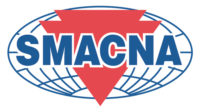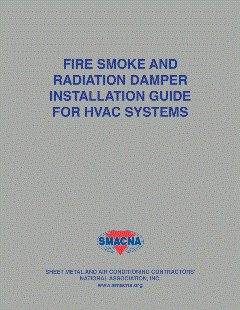SMACNA has released its new edition of the Fire, Smoke, and Radiation Damper Installation Guide for HVAC Systems. The sixth edition features a slew of new information regarding damper installations and updated ICC/UMC/NFPA code references.
The revised standard provides contractors, designers, and other industry professionals with all the information needed to install and inspect fire, smoke, and radiation dampers.
"The process to revive our manuals take a little bit of time. We've been working on this project for several years to incorporate a lot of the newer features in technology and fire rated damper developments that's been out there in the industry over the years," said Eli Howard, executive director of technical services for SMACNA. "As an American national standards developer, which is what SMACNA is, we have to adhere to a pretty strict process to go through a revision of manuals. We follow what's called a consensus-based process on the development of all our standards, and by doing that, we ensure that all affected parties in the industry have the opportunity to engage with SMACNA in the production of the documents. So when we put something out in its final format, which we have now, it's something that has been vetted with the industry."
Because the industry is ever-changing, this standard now features a new series of breakaway fire damper connections, in addition to new information regarding damper testing and inspections. The standard also incorporates new installation configurations and an appendix for building codes.
"We also added a new chapter on the responsibilities for the design professional for laying out on the contract drawings when and where fire dampers are to be provided," Howard said. "One of the big issues we have in the industry is that a lot of engineers will just put something in the specifications or a blanket statement in the drawings that says 'Install all fire dampers as required by code,' and that's not sufficient."
 According to international building code, a design professional must show on the drawings how each and every fire rated penetration is to be protected. That means there are no more blanket statements — details are essential.
According to international building code, a design professional must show on the drawings how each and every fire rated penetration is to be protected. That means there are no more blanket statements — details are essential.
When it comes to mandatory requirements for fire/smoke damper inspection, testing, and servicing, Howard said, "NFPA, specifically NFPA 80, requires for commercial buildings that you test the fire rated dampers once every four years. In a healthcare facility, the test is once every six years."
The test requires a visual test of the damper, Howard noted, which means physically going in to ensure the damper closes and that nothing has been placed in the damper to prevent it from opening or closing.
"The big thing we would like to see pushed is more inspection and servicing of the fire dampers to ensure that when an alarm happens, it's going to activate and it's going to work."
Visit SMACNA's online bookstore to download a PDF of the Fire, Smoke, and Radiation Damper Installation Guide for HVAC Systems or to order a hard copy of the standard.











